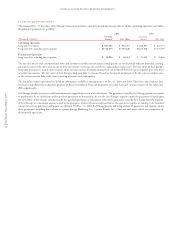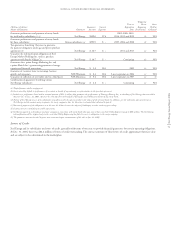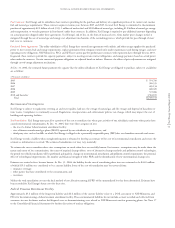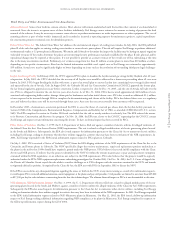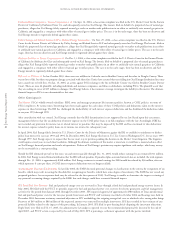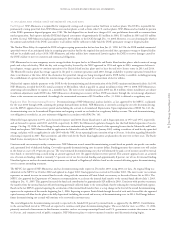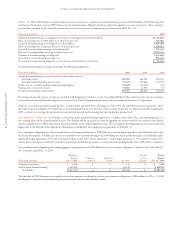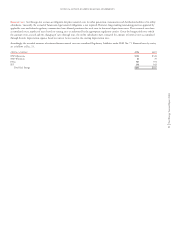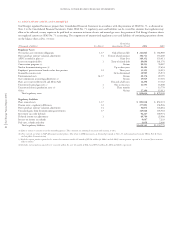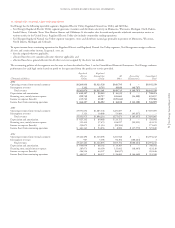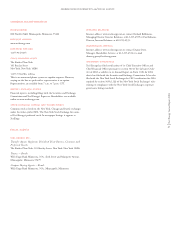Xcel Energy 2004 Annual Report Download - page 83
Download and view the complete annual report
Please find page 83 of the 2004 Xcel Energy annual report below. You can navigate through the pages in the report by either clicking on the pages listed below, or by using the keyword search tool below to find specific information within the annual report.
NOTES to CONSOLIDATED FINANCIAL STATEMENTS
Xcel Energy Annual Report 2004
81
17. NUCLEAR AND OTHER ASSET RETIREMENT OBLIGATIONS
Fuel Disposal NSP-Minnesota is responsible for temporarily storing used or spent nuclear fuel from its nuclear plants. The DOE is responsible for
permanently storing spent fuel from NSP-Minnesota’s nuclear plants as well as from other U.S. nuclear plants. NSP-Minnesota has funded its portion
of the DOE’s permanent disposal program since 1981. The fuel disposal fees are based on a charge of 0.1 cent per kilowatt-hour sold to customers from
nuclear generation. Fuel expense includes DOE fuel disposal assessments of approximately $13 million in 2004, $13 million in 2003 and $13 million
in 2002. In total, NSP-Minnesota had paid approximately $335 million to the DOE through Dec. 31, 2004. However, it is not determinable whether
the amount and method of the DOE’s assessments to all utilities will be sufficient to fully fund the DOE’s permanent storage or disposal facility.
The Nuclear Waste Policy Act required the DOE to begin accepting spent-nuclear fuel no later than Jan. 31, 1998. In 1996, the DOE notified commercial
spent-fuel owners of an anticipated delay in accepting spent nuclear fuel by the required date and conceded that a permanent storage or disposal facility
will not be available until at least 2010. NSP-Minnesota and other utilities have commenced lawsuits against the DOE to recover damages caused by
the DOE’s failure to meet its statutory and contractual obligations.
NSP-Minnesota has its own temporary, on-site storage facilities for spent fuel at its Monticello and Prairie Island nuclear plants, which consist of storage
pools and a dry cask facility. With the dry cask storage facility licensed by the NRC approved in 1994 and again in 2003, management believes it
has adequate storage capacity to continue operation of its Prairie Island nuclear plant until at least the end of its license terms in 2013 and 2014.
The Monticello nuclear plant has storage capacity in the pool to continue operations until 2010. Storage availability to permit operation beyond these
dates is not known at this time. All of the alternatives for spent-fuel storage are being investigated until a DOE facility is available, including pursuing
the establishment of a private facility for interim storage of spent nuclear fuel as part of a consortium of electric utilities.
Nuclear fuel expense includes payments to the DOE for the decommissioning and decontamination of the DOE’s uranium-enrichment facilities. In 1993,
NSP-Minnesota recorded the DOE’s initial assessment of $46 million, which is payable in annual installments from 1993 to 2008. NSP-Minnesota is
amortizing each installment to expense on a monthly basis. The most recent installment paid in 2004 was $4.6 million; future installments are subject
to inflation adjustments under DOE rules. NSP-Minnesota is obtaining rate recovery of these DOE assessments through the cost-of-energy adjustment
clause as the assessments are amortized. Accordingly, the unamortized assessment of $12.6 million at Dec. 31, 2004, is deferred as a regulatory asset.
Regulatory Plant Decommissioning Recovery Decommissioning of NSP-Minnesota’s nuclear facilities, as last approved by the MPUC, is planned
for the years 2010 through 2048, assuming the prompt dismantlement method. NSP-Minnesota is currently accruing the costs for decommissioning
over the MPUC approved cost-recovery period and including the accruals in Accumulated Depreciation. Upon implementation of SFAS No. 143, the
decommissioning costs in Accumulated Depreciation and ongoing accruals are reclassified to a regulatory liability account. The total decommissioning
cost obligation is recorded as an asset retirement obligation in accordance with SFAS No. 143.
Monticello began operation in 1971 and is licensed to operate until 2010. Prairie Island units 1 and 2 began operation in 1973 and 1974, respectively,
and are licensed to operate until 2013 and 2014, respectively. In 2003, the Minnesota Legislature changed a law that had limited expansion of on-site
storage. On Aug. 25, 2004, the Xcel Energy board of directors authorized the pursuit of renewal of the operating licenses for the Monticello and Prairie
Island nuclear plants. NSP-Minnesota filed its application for Monticello with the MPUC in January 2005, seeking a certificate of need for dry spent-fuel
storage, and plans to file an application in early 2005 with the NRC for an operating license extension of up to 20 years. A decision regarding Monticello
relicensing is expected in 2007. Plant assessments and other work for the Prairie Island applications are planned in the next two or three years. The Prairie
Island license renewal process has not yet begun.
Consistent with cost recovery in utility customer rates, NSP-Minnesota records annual decommissioning accruals based on periodic site-specific cost studies
and a presumed level of dedicated funding. Cost studies quantify decommissioning costs in current dollars. Funding presumes that current costs will escalate
in the future at a rate of 4.19 percent per year. The total estimated decommissioning costs that will ultimately be paid, net of income earned by external
trust funds, is currently being accrued using an annuity approach over the approved plant-recovery period. This annuity approach uses an assumed
rate of return on funding, which is currently 5.5 percent, net of tax, for external funding and approximately 8 percent, net of tax, for internal funding.
Unrealized gains on nuclear decommissioning investments are deferred as Regulatory Liabilities based on the assumed offsetting against decommissioning
costs in current ratemaking treatment.
The MPUC last approved NSP-Minnesota’s nuclear decommissioning study request in December 2003, using 2002 cost data. An original filing was
submitted to the MPUC in October 2002 and updated in August 2003; final approval was received in December 2003. The most recent cost estimate
represents an annual increase in external fund accruals, along with the extension of Prairie Island cost recovery to the end of license life in 2014. The
MPUC also approved the Department of Commerce recommendation to accelerate the internal fund transfer to the external funds effective July 1, 2003,
ending on Dec. 31, 2005. This approval increased the fund cash contribution by approximately $29 million in 2003. Consistent with previous treatment,
the transfers from the internal fund are effectively moving previously collected funds to the external fund, thereby reducing the external fund book expense.
Based on the last MPUC approval requiring the acceleration of the internal fund transfer, there is a step change in the level of the overall decommissioning
expense at the expiration of the transfer beginning Jan. 1, 2006. Expecting to operate Prairie Island through the end of each unit’s licensed life, the approved
capital recovery will allow for the plant to be fully depreciated, including the accrual and recovery of decommissioning costs, in 2014. Xcel Energy believes
future decommissioning cost accruals will continue to be recovered in customer rates.
The total obligation for decommissioning currently is expected to be funded 100 percent by external funds, as approved by the MPUC. Contributions
to the external fund started in 1990 and are expected to continue until plant decommissioning begins. The assets held in trusts as of Dec. 31, 2004,
primarily consisted of investments in fixed-income securities, such as tax-exempt municipal bonds and U.S. government securities that mature in one
to 20 years, and common stock of public companies. NSP-Minnesota plans to reinvest matured securities until decommissioning begins.



